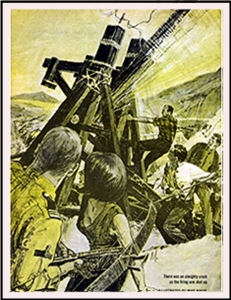Search Results for 'suspense'
Did you find what you wanted ?
Tue 26 Mar 2024
A 1001 MIDNIGHTS PI Review
by Robert E. Briney
STANLEY ELLIN – The Dark Fantastic. John Milano #2. Mysterious Press, hardcover, 1983. Berkley, paperback, 1985.
Stanley Ellin is one of the most honored of contemporary writers of mystery fiction. Beginning with his first story in 1948, he consistently won prizes in the annual short-story contests run by Ellery Queen’s Mystery Magazine. He is a three-time winner of the Edgar Award of the Mystery Writers of America: for Best Short Story in 1954 and 1956 and for Best Novel (The Eighth Circle) in 1958. Four other stories (the most recent in 1983) and one novel have appeared on the short list of nominees for the Edgar. His novel Mirror, Mirror on the Wall ( 1972) was awarded France’s Grand Prix de Littdrature Policifte in 1975.
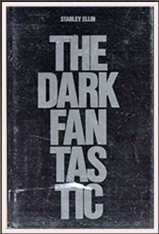
He was elected president of the Mystery Writers of America in 1969, and in 1981 received that organization’s Grand Master Award honoring his lifetime achievement in the mystery field. The point of this litany of awards is that they are all deserved. As a careful craftsman with an ear for language and a deep concern for its proper use, as an acute observer of the human condition, and as an inventive plotter with a flair for the unexpected, Ellin has maintained a consistent level of quality that makes him indeed a grand master of his art.
A string of awards and a proven track record do not, however, guarantee that publishers will jump to accept a book with potentially controversial elements. The Dark Fantastic was rejected by several major publishing houses before being picked up by a relatively small specialty publisher. It subsequently gathered a stack of favorable reviews in the United States, sold to a major British publisher, and has become a feather in the cap of the Mysterious Press.
The story alternates between two viewpoints: that of Charles Witter Kirwan, a retired college professor with madness eating at his brain just as cancer is eating at his body; and that of John Milano, a private detective first introduced in Star Light, Star Bright (1979), who specializes in the recovery of stolen works of art. Kirwan, reluctant landlord of an apartment building in a black neighborhood in Brooklyn, plans to blow up the building with himself and his black tenants inside. Among the tenants are the family of Christine Bailey, who works as a receptionist in a Manhattan art gallery currently under investigation by Milano.
From this tenuous connection, the paths of Kirwan and Milano are drawn inexorably together. Ultimately, Milano is the only person who has a chance to uncover Kirwan’s plot; but can he stop it in time? Ellin tightens the screws expertly. and the suspense intensifies up to the very end.
Kirwan’s chapters are in the form of transcripts of a tape-recorded journal in which he attempts to explain the reasons for his destructive plan, while recounting the day-to-day progress toward its accomplishment. The transcripts are studded with racial invective-not mere ethnic name-calling, but the type of inventive viciousness that an educated mind can apply to the expression of its prejudices.
These passages make uncomfortable reading, especially in view of the skill with which Ellin takes us into Kirwan’s mind and makes us understand the familial and societal roots of his attitudes. Another source of discomfort for some readers lies in the explicit descriptions of Kirwan’ s sexual victimization of Christine’s teenaged sister.
But Ellin handles this highly charged material with assured skill and without a hint of sensationalism. The book is a serious psychological study, a detective story, an unusual love story, and an exercise in down-to-the-wire suspense: a worthy addition to the author’s already impressive body of work.
———
Reprinted with permission from 1001 Midnights, edited by Bill Pronzini & Marcia Muller and published by The Battered Silicon Dispatch Box, 2007. Copyright © 1986, 2007 by the Pronzini-Muller Family Trust.
Tue 5 Mar 2024
A 1001 MIDNIGHTS Review
by Newell Dunlap & Bill Pronzini
WESSEL EBERSOHN – Divide the Night. Pantheon, 1981. Vintage Books, softcover, 1982.
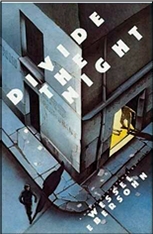
It must be strange to have one’s books banned in one’s own country, but such is the case with Wessel Ebersohn, a native and resident of South Africa who records that society as he sees it, blemishes and all. Consider his description of Johannesburg’s citizens:
“There were the super-liberals who almost felt ashamed to be white. There were the most violent and desperate racialists who would willingly kill to protect a position of privilege. There were artists and railway workers, Jews and anti-semites, nuns and whores, millionaires and the dispossessed …”
Divide the Night is an intelligent and provocative novel featuring Yudel Gordon, a prison psychologist who also treats private patients. One such patient is a man named Johnny Weizman, who has the rather antisocial habit of leaving his storeroom door open all night and shooting any intruder — usually blacks, of whom he has already killed eight. As far as Yudel is concerned, Weizman is a fanatic and psychotic racist; the Special Police, however, consider him a patriotic citizen, and are much more interested in a fugitive black leader named Mantu Majola who witnessed Weizman’s last murder and who just might (the security police hope) return to settle the score with the racist shopkeeper.
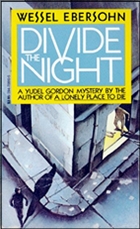
Caught up in the middle is Yudel, who has troubles of his own-primarily a nagging wife who feels he does not have the proper attitude toward money. Yudel is a highly sympathetic character, well drawn and very human. Similarly, Ebersohn’s other characters come across as real people, which makes us care about the things that happen to them in, and as a result of, the restricted society in which they live.
The New York Times Book Review called Divide the Night “a powerful book and a well-written one that just happens to fall within the genre of the police procedural.” The same could be said of the first Yudel Gordon suspense novel, A Lonely Place to Die (1979). Also impressive is Ebersohn’s non-series suspense novel, Store Up the Anger (1980).
———
Reprinted with permission from 1001 Midnights, edited by Bill Pronzini & Marcia Muller and published by The Battered Silicon Dispatch Box, 2007. Copyright © 1986, 2007 by the Pronzini-Muller Family Trust.
Sun 5 Nov 2023
Posted by Steve under
Reviews[5] Comments
REVIEWED BY DAVID VINEYARD:
PAMELA FRANKAU – Colonel Blessington. [Completed by Diana Raymond.] Bodley Head, UK, hardcover, 1968. Delacorte, US, hardcover, 1969. Dell 1378, US, paperback, 1970.

Absurd to feel that he was followed. But the feeling persisted. Standing outside the St. Francis Hotel, while the doorman hailed a Yellow Cab, Harvey Blessington looked over his shoulder, then looked right and left taking in a wide angle from side to side of Union Square. This was the feeling that haunted his dreams. For years he had dreamed intermittently of being back, being followed.
And well he might. Harvey Blessington is many things to many people. To most he is a war hero, the brave Colonel Blessington, to Anthony Price he is the man who ought to replace the candidate for Parliment they both support, to actress Anita Gilroy he is object of her first love, and to her father Matthew, he is his ex-commando comrade in arms and the object of an obsessive memory a nightmare running “like a dark river underground, until he also becomes the object of fear and a mystery that remains unsolved.”
Like quicksilver Harvey Blessington seems always changing shape, sometimes a shadow, sometimes bright as the sun, sometimes dark and strangely threatening. At the heart of Harvey Blessington is a mystery, one just beyond belief, at once revealing and impossible to believe.
One worth men’s lives to keep hidden.
Colonel Blessington was the final novel by British novelist Pamela Frankau, and her first suspense novel venturing into the kind of duality and uncertainty of a Graham Greene or Patrica Highsmith. Frankau grew ill and died while writing the book and her friend novelist Diana Raymond finished the book from her extensive notebooks. While the novel was recognized in its time and critically praised in both Britain and here, her death perhaps overshadowed the novel which isn’t half as well known as it once was.
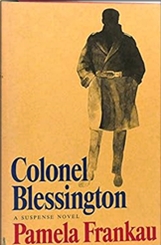
Frankau was the daughter of British literary gadabout Gilbert Frankau, who abandoned her and her mother when she was small. She went on to become a famed and critically praised novelist on her own, her some sixteen novels such as A Wreath for the Enemy, Over the Mountain, and Clothes of a King’s Son, among her better known works.
As Matthew Gilroy finds himself hunted and hunter going to ground to uncover the enigma of Blessington, the tension ratchets up and the need to solve the mystery of Harvey Blessington a matter of life and death.
…you came up here prepared to kill me.
Why?
You were the man who killed beside me in the war, all those years ago, But — to kill me for that? You were so sure you would kill me you boasted of another murder; of a girl that haunted you… Why?
Blessington is something of a tour-de-force, pulling off a twist worthy of Agatha Christie. It’s one of those books that cleverly lays the groundwork for its key revelation so you can look back and see each clue and misdirection, yet has a solution so shocking that you won’t guess it ahead of time, Blessington’s ultimate flaw “…to take people’s lives and spoil them — a love of power. A common love brought to extremes —â€
I first read Colonel Blessington when it came out back in 1968. It still holds up today, its final revelation still as stunning and chilling as it was then, its quiet shocks coming with a chill to the bone and a recognition of our own prejudices and blindness when we fail to see the obvious right in front of us and recognize the duplicitous Blessingtons in our own lives.
Thu 2 Nov 2023
A 1001 MIDNIGHTS Review
by Robert J. Randisi & Marcia Muller
WARWICK DOWNING – The Player. Joe Reddman #1. Saturday Review Press, hardcover, 1974. No paperback edition.
‘The Player” is Denver private investigator Joe Reddman. He was given his Cheyenne name, Nataq, nha-ewo-tsimtisi,” by Bluetree Woman, the Indian who raised him. It means “Man Who Plays Garne” — and Reddman plays his particular game very well.
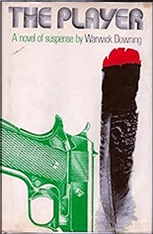
In this first recorded case, Reddman is hired by a man named Aaron Cane to clear his nephew, a rookie cop named Denny McLoughlen, of a murder charge. At the same time, he takes on another job — to look into a two-year-old, $450,000 bank robbery involving an armored car that was decked out as a stagecoach. He soon discovers the two cases are connected, but before he can uncover exactly how and why, Denny McLoughlen is murdered. That, plus his growing involvement with Denny’s girlfriend, complicates his efforts, and more murder and mayhem lead up to an action-packed climax.
Downing’s grasp of Denver’s history recalls a rough-and-tumble past that is coated with only a thin veneer of elegance. and the Rocky Mountain scenery is used to exceptionally good effect. Joe Reddman is an interesting character, a man of great integrity, and it is a shame that he has appeared as the main character in only one other novel — intriguingly titled The Gambler, the Minstrel, and the Dance Hall Queen (1976), in which an old legend from the mining camps on the south slope of Pike’s Peak seems to be repeating itself in present times. He also has a cameo appearance in The Mountains West of Town (1975), which features lawyer Nathan Tree.
These three novels comprise Downing’s entire contribution to crime fiction. One hopes that others will be forthcoming.
———
Reprinted with permission from 1001 Midnights, edited by Bill Pronzini & Marcia Muller and published by The Battered Silicon Dispatch Box, 2007. Copyright © 1986, 2007 by the Pronzini-Muller Family Trust.
Bibliographic Update: There were no further adventures of Joe Reddman, but Warwick Downing did publish six later novels which appear to be genre work, either westerns or mystery/suspense titles.
Fri 22 Sep 2023
REVIEWED BY MIKE TOONEY:

THE LEOPARD MAN. RKO, 1943. Cast: Dennis O’Keefe, Margo, Jean Brooks, Isabell Jewell, Marguerite Silva, Abner Biberman, James Bell, Margaret Landry, Fely Franquelli, Ariel Heath, Tuulikki Paananen. Producer: Val Lewton. Writers: Ardel Wray and Edward Dein, based on the novel Black Alibi (1942) by Cornell Woolrich. Director: Jacques Tourneur.
“You don’t get the idea, mister. These cops banging those pans, flashing those lights, they’re gonna scare that poor cat of mine. Cats are funny, mister. They don’t want to hurt you, but if you scare them they go crazy. These cops, they don’t know what they’re doing.”
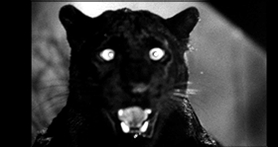
Despite what everybody says about The Leopard Man, it’s not really a horror film. Of course it looks and even sounds like one most of the time, and it’s true producer Val Lewton specialized in horror films (e.g., Cat People, I Walked with a Zombie, etc.). Nevertheless, when you eliminate all the terror trappings, what’s left isn’t just a crime movie but an actual mystery film.
It’s clear the intention was to ratchet up the suspense as much as possible — and then go beyond that. So it’s surprising to realize that just about every moment of violence is off screen; lighting and sound effects do the job of suggesting the horrors we don’t see.
“Mamacita, let me in! Let me in! Let me in! If you love me, let me in!”
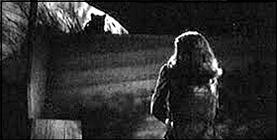
When someone is attacked and murdered on one side of a door, we and another person on this side of it hear the violent scuffle but only see the victim’s blood oozing under the door.
In a darkened cemetery dimly lit by a hazy moon, another victim is stalked by something unseen up in the trees. The camera focuses on the tree limbs as they creak downward and then spring up, with the attacker just out of visual range. All we hear is a muffled scream.
The Leopard Man has many moments like that. The source material was Black Alibi, a 1942 novel by Cornell Woolrich.
****
Numerous books and stories by Cornell Woolrich have been adapted for other media, such as these films: ‘Convicted’ (1938), ‘Street of Chance’ (1942), ‘Phantom Lady’ (1944), ‘The Mark of the Whistler’ (1944), ‘Deadline at Dawn’ (1946), ‘Black Angel’ (1946), ‘The Chase’ (1946), ‘Fall Guy’ (1947), ‘The Guilty’ (1947), ‘Fear in the Night’ (1947), ‘The Return of the Whistler’ (1948), ‘I Wouldn’t Be in Your Shoes’ (1948), ‘Night Has a Thousand Eyes’ (1948), ‘The Window (1949), ‘No Man of Her Own’ (1950), 6 episodes of the ‘Suspense’ TV series (1949-50), 3 segments of ‘Robert Montgomery Presents’ (1950-51), ‘Rear Window’ (1954), ‘Obsession’ (1954), ‘Nightmare’ (1956); 3 installments each of ‘Lux Video Theatre’ (1954-57), ‘The Ford Television Theatre’ (1955-57), ‘Alfred Hitchcock Presents’ (1956-58), and ‘Thriller’ (1961); ‘The Bride Wore Black’ (1968), ‘You’ll Never See Me Again’ (1973, TVM), even ‘Mrs. Winterbourne’ (1996) — and this list of media adaptations is hardly exhaustive.
Wed 20 Sep 2023
A 1001 MIDNIGHTS Review
by Ellen Nehr
DORIS MILES DISNEY – Who Rides the Tiger. Doubleday Crime Club, hardcover, 1945. Ace, paperback, 1965. Zebra, paperback, 1989.
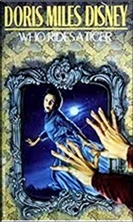
Unlike so many other authors, Doris Miles Disney never wrote the same book twice, even though she frequently used Connecticut as a background and always included a romantic element. In this novel, flashbacks that sometimes catch the reader unaware create a tangled, two-layer story of a great-aunt’s will, an old house filled with a lifetime accumulation of furniture and memories, and fourteen diaries that intrigue (as well as confound) the modem-day heroine, Susan.
Her search for the motive behind her impoverished father’s exclusion from Great-Aunt Harriet’s will is aided by a recently returned Army Intelligence officer, Philip, who has a stake in the past, as well as a deep interest in Susan’s future. This story could justifiably be called a Gothic, since it involves tangled family relationships. an old house, and all the other trappings; but its mounting feeling of suspense and terror transcends the form and makes Who Rides the Tiger a startling tale of malevolence.
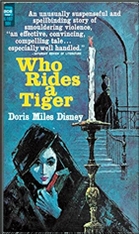
Disney’s skill at creating dialogue and atmosphere is also evident in her other non series books, including Testimony by Silence (1948), No Next of Kin (1959), Voice from the Grave (1968), and Cry for Help (1975). In addition, she created three series characters: insurance investigator Jeff DiMarco, who is featured in such titles as Dark Road ( 1946), Method in Madness (1957), and The Chandler Policy ( 1971 ); postal inspector David Madden, who appears in Unappointed Rounds (1956), Black Mail (1958), and Mrs. Meeker’s Money (1961); and small-town Connecticut policeman Jim O’Neill, who is the hero of such early novels as A Compound of Death (1943) and The Last Straw (1954).
———
Reprinted with permission from 1001 Midnights, edited by Bill Pronzini & Marcia Muller and published by The Battered Silicon Dispatch Box, 2007. Copyright © 1986, 2007 by the Pronzini-Muller Family Trust.
Wed 13 Sep 2023
Posted by Steve under
Reviews[5] Comments
REVIEWED BY DAVID VINEYARD:
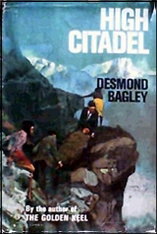
DESMOND BAGLEY – High Citadel. Collins, UK, hardcover, 1965. Doubleday, US, hardcover, 1965. Pocket, US, paperback, 1966. Pyramid, US, paperback, 1972. Harper, paperback, 2009, in a 2-for-1 edition with Landslide. A condensed version appeared as a “book bonus” in the August 1965 issue of Argosy Magazine (see the illustration taken from that issue at the end of this review).
Tim O’Hara is a down on his luck ex alcoholic pilot working for a fledgling airline flying in the Andes.
A Dakota was being loaded and, even at that distance, the lights were bright enough for O’Hara to see the emblem on the tail – two intertwined ‘A’s, painted artistically to look like mountain peaks. He smiled gently to himself. It was appropriate that he should fly a plane decorated with the Double-A; alcoholics of the world unite – it was a pity Filson didn’t see the joke. But Filson was very proud of his Andes Airlift and never joked about it. A humourless man, altogether.
O’Hara’s job is to ferry a disparate group of passengers over the Andes to their destination, and he has no idea how challenging that is going to prove to be.
Grivas (the radioman) said softly, ‘Señor O’Hara.’
‘Don’t bother me now.’

‘But I must,’ said Grivas, and there was a tiny metallic click.
O’Hara glanced at him out of the corner of his eye and stiffened as he saw that Grivas was pointing a gun at him – a compact automatic pistol. He jerked his head, his eyes widening in disbelief. ‘Have you gone crazy?’
Grivas’s smiled widened. ‘Does it matter?’ he said indifferently.
Hijacked, they crack up on a mountain landing strip too small for the Dakota, and O’Hara and his ten passengers find themselves in an even worse situation than surviving a plane wreck. Cordillera, the small country on the South American continent where they have gone down is currently held by a Communist dictator and one of the passengers is his chief opponent.
Naming any single book by a writer like Desmond Bagley his best is tricky business, especially when the competition includes The Vivero Letter, Running Blind, Freedom Trap (filmed by John Huston as The MacKintosh Man), The Spoilers, Bahama Crisis and some of the best reviewed thrillers of the latter half of the 20th Century.
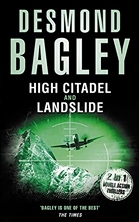
Bagley was a South African actor (Basil Rathbone was a cousin, also a cousin of Daphne DuMaurier) turned writer who turned an eye for the telling detail, a knowledge of character as well as plot construction likely from his acting experience, and a natural talent for twisty plots that took dangerous turns for reader and protagonists into a series of top selling novels. As an adventure writer, he rivaled Alistair MacLean at his best for sheer pace and action while his mystery plots would not be lost in an Agatha Christie book. He was soon rivaling Hammond Innes and MacLean in sales and surpassing such masters as Victor Canning, Gavin Lyall, and Geoffrey Household in name recognition.
Virtually overnight he went from obscurity to one of the best known practitioners in the field of the classic British adventure thriller.
Unlike those masters, Bagley never wrote the same book twice. Each Bagley novel is unique in voice, subject, and style as at home with the first person narrator favored by the John Buchan school as the third.
Above all, his books are entertaining page turners, never teased by success into over extending themselves or pretension. Bagley recognized his strengths as a writer early and honed them while still remaining fresh and maintaining the ability to surprise his readers.
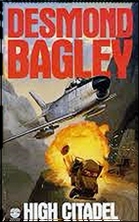
High Citadel is an early book, but one that shows a skilled hand. It is a shade more novelistic than some of his work, more in line with Nevil Shute, Ernest K. Gann, or David Beatty than the standard thriller, but it never forgets it is primarily and adventure story written to entertain and provide escape from the workaday world which it does with thrills, chills, and not a little wit.
At heart it is a Grand Hotel plot. A disparate group of people who share nothing but the coincidence of being passengers on a flight that goes down in the middle of a South American revolution and have to make their way out of rebel territory to safety must battling human nature, their own foibles and flaws, nature, those who want to take them hostage or murder them, and finding in themselves the ingenuity and strength to survive.
It’s a pity it was never filmed because you can easily imagine the cast, including an old maiden New England school teacher who is a deadly accurate archer born to be played on screen by an Edna May Oliver type and an aging medievalist who happens to know how to make a crossbow.
I read this sometime in the Seventies and there are passages as vivid today in my mind as when I read them for the cinematic wide screen quality of some of the set pieces and the human well drawn characters.
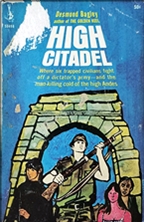
The hero, battling his own demons, must overcome them and hold together his small army of strangers, uncertain who can be trusted and well aware they are surrounded by ruthless Cuban-trained soldiers willing to murder them all to get to the one man among them they are hunting.
Inevitably their luck runs out and the high citadel they have created faces an onslaught of superior force.
‘I’m sorry to be pessimistic,’ he said. ‘But I think this is the last act. We’ve done very well considering what we had to fight with, but it couldn’t go on for ever. Napoleon was right – God is on the side of the big battalions.’
Her voice was savage. ‘We can still take some of them with us.’ She grasped his arm. ‘Look, they’re coming.’
Signaling a battle royal that runs right up to the wire with action, suspense, and the heart that too few modern adventure writers manage to instill for all their pyrotechnics.
High Citadel is a fine read, a top notch thriller, but something more with human characters you care about and all from the hand of a sure master who hit the ground running from his first printed word and never looked back. For thrills and consistent brilliance it is hard to top Bagley.
This is thriller writing at its best.
Thu 7 Sep 2023
REVIEWED BY BARRY GARDNER:
MARELE DAY – The Disappearances of Madalena Grimaldi. Claudia Valentine #4. Walker, hardcover, 1996. First published in Australia by Allen & Unwin, paperback, 1994.
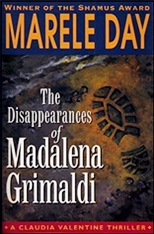
I missed the first of these (*), which won a 1993 Shamus —The Last Tango of Delores Delgado. The title deserved an award, anyway. Claudia Valentine is an Australian Pl operating out of Sydney, though a good bit of the action takes place in Melbourne.
Claudia Valentine has just found out that her father, who deserted her mother and her when she was a child, died a derelict a decade ago. At about the same time she takes the case of a runaway and missing 15 year old child. The father is an intemperate and maybe brutal man, the mother emotionally (at least) bruised. So Claudia has two cases, though she’s only getting paid for one: find the missing girl, and a dead father she didn’t know she’d missed, but who now obsesses her.
There are two stories here, obviously, and I’ll save you some suspense and tell you that they’ re not connected. The personal search is the primary story; indeed, I found the putative main plot to be almost an afterthought, and not that interesting. Which isn’t to say it was a bad book — it wasn’t. Day writes very readable first-person prose, and Valentine is a believable and likable character
Still, here’s another not-too-thick “mystery” that without a sub-plot wouldn’t be a book, only partially redeemed by the fact that the subplot does involve detection.
—
(*) Steve here. The books were apparently published out of order in the US, if at all. Here’s a list of all four books as (I assume) they appeared in Australia:
1. The Life and Crimes of Harry Lavender (1988)
2. The Case of the Chinese Boxes (1990)
3. The Last Tango of Dolores Delgado (1992)
4. The Disappearances of Madalena Grimaldi (1994)
Tue 15 Aug 2023
A 1001 MIDNIGHTS Review
by Marcia Muller
PETER DICKINSON – The Last Houseparty. Pantheon, US. hardcover, 1982. Published earlier in the UK by Bodley Head, hardcover, 1982.
Peter Dickinson is both the author of classical detective stories and a reviewer of mystery fiction for Punch, where he was an assistant editor for seventeen years. His early novels featured the very British Superintendent James Pibble of Scotland Yard; in many of his later books he moved into the area of psychological suspense and amateur detection.
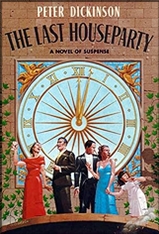
Although the structure of the majority of his stories is classic-a murder, a number of suspects. and often a closed environment such as the English country house-the settings and characters are anything but ordinary. As Dickinson himself says, “I tend to overpopulate my books with grotesques.” But if he tends to the bizarre or eccentric, Dickinson also has the ability to make us believe implicitly in the existence of these people and places, and in the plausibility of the events they participate in.
The Last Houseparty is a historical mystery set in three time frames: 1937, when most of the action takes place; 1940 (briefly); and 1980, when the mystery is resolved. The author tends to skip among these without giving the reader much warning, and in the first few chapters this is very disorienting; after we become familiar with the characters, it is easier to recognize which time frame we are in.
The main action of the novel takes place at Snailwood, a grand English estate whose tower contains a fabulous clock, replete with moving figures that perform on the quarterhour. In 1937 the estate is the domain of Lord Snail wood and his second wife, the Countess Zena. who is famous for her weekend “dos” and “superduperdos” to which illustrious personalities are summoned. Zena’s current house party is to be a political one, and various people — including an Arab prince, a professor with high connections, and Lord Snailwood’s two nephews, one a publisher, the other a soldier — are to debate, in bright cocktail-party chatter, the world situation.
The weekend begins successfully, with even a budding romance between Countess Zena· s new secretary and the publisher nephew in the offing. But it soon degenerates and dark events take place that result in the traumatization of a young girt, the disappearance of the soldier nephew, an old man’s near fatal heart attack, the clock stopping permanently-and this being the last of Zena’s famous parties.
Of course, Dickinson does not reveal all these events at once; the story builds slowly, beginning in the present, with Snailwood now a “stately home” open for public display by the financially strapped heir. He then takes us back to 1937 and the arrival of the party guests; next, forward to the African desert in World War II. We gradually realize that terrible events have destroyed the Snailwood family, and we see what they apparently were, we also realize that there is even more under the surface. This is an intriguing novel that will keep you guessing right up to the final revelations.
———
Reprinted with permission from 1001 Midnights, edited by Bill Pronzini & Marcia Muller and published by The Battered Silicon Dispatch Box, 2007. Copyright © 1986, 2007 by the Pronzini-Muller Family Trust.
Mon 14 Aug 2023
Posted by Steve under
Reviews[5] Comments
REVIEWED BY DAVID VINEYARD:
DONALD HENDERSON – A Voice Like Velvet. Random House, US, hardcover, 1946. Previously published in the UK as The Announcer (Hurst, 1944), as by D. H. Landels. The Detective Club [Collins], UK, hardcover/paperback, 2018/2021, with the inclusion of the short story, “The Alarm Bell.” Introduction by Martin Edwards.
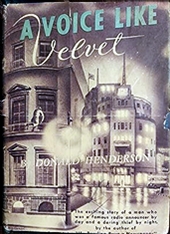
Mr. Ernest Bisham kept as still as possible behind the green velvet curtains and listened to the clock ticking, Suddenly he slipped from behind the curtains and made for the door. He went unchallenged along a corridor and opened the first door he came to. Nobody was in it, it was a bedroom. He went to the window and softly opened it. A few minutes later he was hurrying along a side street and panting slightly.
Ernest Bisham is a cat burglar, a second story man, known by Scotland Yard as “the Man in the Mask.†He is not quite Raffles or the Baron, being middle aged, married, and a bit heavier than he was when he was younger. He lives with his wife Marjorie and his sister Bess, and is both highly respected, and a fixture in every home within the broadcasting range of the Broadcasting House (think BBC which Henderson wrote for creating the first soap opera broadcast, Front Line Family, later known as The Robinsons, and the radio play The Trial of Lizzie Borden among others) as the voice of Broadcasting House, Ernest Bisham, the Announcer, newsreader, famed for his closing, “… and this is Ernest Bisham reading it,†in a voice compared to velvet.
For Americans unfamiliar with the UK and the BBC (*) it is hard to comprehend the role the legendary voice of the BBC played in dominating a culture and a way of life, From Buckingham to Whitechapel from the South of England to the Midlands and the North the voice of the BBC was a fixture, a respected and admired figure, the calm assured vaguely upper class sounding voice of a nation, particularly during the War years.
And in Ernest Bisham’s case that voice belongs to a thief.
Without berating the point, the novel quietly puts the reader into the mind and ego of Mr. Bisham but never bores with heavy-handed psychological breast beating. Finding that balance between the melodrama of a thriller (the realm of most gentleman cracksmen) and the dark near Gothic brocade of the serious crime novel Henderson manages to walk a tightrope never making a misstep. Though not as dark as Gerald Kersh’s Prelude to Midnight and Night and the City, Henderson is in the same vein of sharply observed recognizable humans in crisis.
Henderson was an admirer of John Dickson Carr, but he began writing in the shadow of Francis Iles (Anthony Berkeley) and his work is informed by the Iles’ books Malice Aforethought and Before the Fact, two works that freed the British crime novel from the Golden Age mode of the detective story and aristocrats dying in vast manor houses on isolated weekends.
Most writers are lucky to write one classic genre novel over long careers. Some have more, but they are scattered over years of writing and working in the field, and some few like Dashiell Hammett and Raymond Chandler have their whole output considered classics.
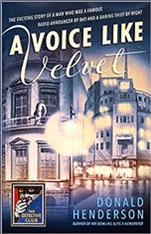
But it is a rarity to find a writer who only wrote three books, two in the genre of crime fiction, and those two books both classics in the field.
Mr. Bowling Buys a Newspaper was Henderson’s first book, and the better known of the two, the story of a serial killer who only reads the paper after a kill in hope that the police are going to stop him before he kills again. That book was highly praised by critics and writers including Raymond Chandler (who claimed to have read it three times) and Ian Fleming.
A Voice Like Velvet took a more torturous route to its stature as a classic of the crime genre.In fact the book was first published in the UK in 1944 during the War as a mainstream novel as The Announcer, and it was not until its American publication that it was recognized as a classic of the crime genre under the better known American title by Random House.
Driven by the compulsion to spice his life with excitement, Bisham’s chosen manner is cat burglary, he is well aware that he risking everything he has earned, that his marriage, his life, his prestige, are all endangered by his recklessness, and now Chief Inspector Hood has Bisham in his sights and is having him followed, which makes the game even more exciting. As Hood assures him cat to potential mouse:
“I know the public likes to weave its own romance out of things, eh? The life of a detective is supposed to be the most exciting life!†he laughed. “And so is the life of an Announcer, Mrs. Hood assures me of that,†he laughed again. “And so is the life of a cat burglar! Or I suppose! I suppose the public will be very upset if the Man in the Mask is sent to prison. There’s something unromantic about years of penal servitude!â€
While there is suspense and action in the book it is not a thriller. Like Iles, whose work inspired it, the suspense rises from the thoughts and actions of the protagonist, his compulsion, his quick wits, and his inevitable mistakes, but unlike Iles, A Voice Like Velvet would make a delightfully dark Ealing comedy
This was Henderson’s best reviewed novel despite its first small print run. He died at age 41 shortly after it was published in the States under its better known title, and was recently brought back in print in the UK as Velvet by the Detective Club with an attractive jacket, and introduction by genre writer, historian, and editor Martin Edwards, and with “The Alarm Bell†a powerful short by Henderson.
A Voice Like Velvet is well worth your time, a classic of British crime fiction both charming, suspenseful, and ironic.
(*) For anyone interested there is another classic of BBC crime fiction, Death at Broadcasting House (1934) by Val Gielgud and Eric Maschiwitz as Holt Marvell, which was filmed and could recently be seen on YouTube.
















